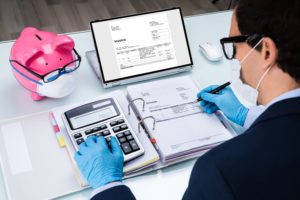Focus on Maine
This month we travel up the eastern seaboard to the Pine Tree State of Maine. Maine is the northeasternmost state in the contiguous United States. It is known for its jagged rocky coastline, low, rolling mountains, heavily forested interior, picturesque waterways, and its seafood cuisine, especially clams and lobster.
Maine was part of the Commonwealth of Massachusetts until 1820 when it voted to secede from Massachusetts to become a separate state. There is no definitive explanation for the origin of the name “Maine,” but the most likely explanation is that early settlers named it after the former province of Maine in France.
What To Know About Certain Tax Obligations In California
 Are you a remote seller making sales into California through a marketplace seller like Amazon? Do you have inventory within the state?
Are you a remote seller making sales into California through a marketplace seller like Amazon? Do you have inventory within the state?
What about remote workers? Do you have any employees that are now working from home across state lines?
If you answered yes to any of the above questions, I encourage you to keep reading!
California's Franchise Tax Board (FTB) recently sent out notices to online merchants demanding income tax returns, part of a larger effort to collect taxes from remote sellers with inventory within the state. While in-state businesses have received similar notices for a number of years, the recent focus on out-of-state retailers may trace back to the 2018 Wayfair decision and the implementation, and enforcement of, Wayfair-related legislation within California.
Unlike remote sellers that make sales independently, and as a result, manage their own inventory, marketplace sellers may find these income tax obligations to be an unpleasant surprise. This includes retailers who make sales through Amazon's Fulfilled By Amazon (FBA) platform. Amazon is notorious for moving inventory without informing sellers, sometimes even into new states without the seller's knowledge.
As a result, marketplace sellers may be faced with new tax obligations in California they were previously unaware of if they meet certain annual thresholds.
While this may seem like an unfair reach by the FTB, we remind our readers that having inventory in the state (even if you didn't necessarily know you had inventory in CA), constitutes physical presence - and creates nexus for both sales tax and income tax purposes. It always has. The difference is the FBA program has now presented taxpayers with a challenge they weren't expecting. The rub is many participants in the FBA program don't know (or didn't previously know), where exactly their inventory was being stored, and likely didn't realize that it created a physical presence for them in California. Or in any other state Amazon stored the seller's inventory. California is getting some headlines about this now, but stay tuned for this shoe to drop in other states as well.
On the other hand, despite the crackdown on marketplace sellers, California has shown leniency when it comes to tax obligations created by remote workers. Of course, this is specific to remote workers who have been forced to shelter in place due to the pandemic, but the recent guidance from the FTB has been a relief to many companies that were unsure how the extended need for remote workforces would impact tax obligations.
As stated on the FTB website, "California will not treat an out-of-state corporation whose only connection to California is the presence of an employee who is currently teleworking in California due to Executive Order N-33-20 as being actively engaged in a transaction for the purposes of financial or pecuniary gain or profit."
This means remote workers alone will not result in a business being classified as "doing business" within the state. However, if a business has other ties to California, which already meet the state's minimum thresholds for property, payroll or sales, it will be considered to be conducting business within the state.
If you have questions regarding your tax liability in California, or any other state sales tax compliance questions, please contact us today. We're happy to clarify any multi-state tax issues you're trying to navigate.
It's the Season to be Thankful!

and healthy Thanksgiving!
Many of you visit our blog for insightful articles about state tax matters. However this week, we’d like to stop for a moment and reflect on the past year and on the things that we have to be thankful for.
This year has certainly thrown us a few curve balls. With the onslaught of the coronavirus pandemic, life has changed drastically as many people work from home and students have switched to distance learning. At Miles Consulting, our team members are dealing with the issues of working from home, home schooling children, visiting grand-kids online, and canceling vacations, and other outings. But, thankfully, most of us aren’t dealing with “front line” issues. And we are very thankful for the essential workers in hospitals, doctors’ offices, grocery stores and other places that enable us to carry on with daily life, so that it can seem somewhat normal.
When Is Distance Learning Subject To Taxation? It depends.
 Just like the many employees who have been forced to adapt to remote working, students across the nation have transitioned to distance learning as a result of the pandemic. While universities have previously offered online options for a minority of classes, the pandemic has rapidly pushed the majority of instruction online.
Just like the many employees who have been forced to adapt to remote working, students across the nation have transitioned to distance learning as a result of the pandemic. While universities have previously offered online options for a minority of classes, the pandemic has rapidly pushed the majority of instruction online.
As is the case for companies with remote workforces, universities may now be facing changed and possibly increased tax obligations. However, rules on the taxation of online schooling vary wildly by state, and if students are now located in a different state than their school because of displacement by the pandemic, it gets even more complicated.
The 2018 Wayfair decision paved the way for states to implement economic nexus legislation. Today, over 40 states have implemented some form of economic nexus. In a nutshell, this allows states to require remote sellers to collect and remit sales taxes based on the seller's economic presence alone, typically measured by way of sales thresholds or the number of sales transactions made per year.
For universities, online education and other training courses offered by these institutions may or may not fall under the purview of economic nexus, depending on the state.
In the time of COVID-19, universities may now be offering instruction in states they have not previously, or the number of students enrolled in these classes may have increased to the point of triggering economic nexus. However, the next point of contention is whether distance learning is even taxable in those specific states.
Unfortunately for universities, it will not be a single answer across the board.
Regardless of economic nexus, online classes being taught to in-state students may or may not be taxable, again depending on the state as well as the type of class.
In Tennessee, for example, live, instructor-led online courses are not subject to Tennessee sales and use tax, but self-paced online classes with no live instruction components are taxable.
This is an example of how removing even one element from the distance learning equation (in this case, live instruction) can change the definition of those courses from a service to a digital good, which often also changes its taxability.
Another determinant of taxability is the type of school or program that is offering the online instruction.
There are generally two categories that schools will fall into: government/non-profit institutions or for-profit/private institutions. Typically, the education tax exceptions that government/non-profit institutions enjoy are not available to for-profit/private institutions. So, when it comes to distance learning, for-profit and private institutions are more likely to face tax obligations due to online instruction.
You might now be wondering why this matters to anyone outside of universities or other learning institutions.
Beyond the potential changes to tax legislation as a result of the new tax burdens faced by universities, it also matters because companies that are providing the technology needed to facilitate distance learning (whether in a single sale format or SaaS) may also face increased tax ramifications.
In these instances, the impact of economic nexus and determining whether the courses will be considered taxable matters just as much to the company facilitating the distance learning as it does to the university offering the courses.
If you have questions regarding tax liability brought about by the sale of software to universities or other learning institutions, or any other state sales tax compliance questions, please contact us today. We're happy to clarify any multi-state tax issues you're trying to navigate.
Focus on Mississippi

This month we travel to the land of Dixie, the southern state of Mississippi. The state is the 32nd largest and 34th most populous of the 50 states. The state is heavily forested with over half of the state’s area covered by wild trees including mostly pine, as well as cottonwood, elm, hickory, oak, pecan, sweetgum and tupelo.
How Will the Pandemic Impact Sales Taxes In The Long Run?
 As states across the nation continue to struggle with immediate concerns related to the pandemic, lawmakers are turning their sights to the future and looking for ways to make up the massive budget shortfalls brought on by COVID-19.
As states across the nation continue to struggle with immediate concerns related to the pandemic, lawmakers are turning their sights to the future and looking for ways to make up the massive budget shortfalls brought on by COVID-19.
One potential avenue is sales tax. There are a variety of ways that legislators could change or implement sales taxes to increase revenue. In the following article, we’ll examine these and other long-term changes that we may see over the coming months and years as a result of the pandemic.
Economic Nexus Legislation
For a breakdown of economic nexus and the impact it has had over the last two years, please click here.
An ongoing theme of the pandemic has found states with robust economic nexus legislation faring (at least slightly) better than those without. While over 40 states have now enacted economic nexus laws, there are still two states with a general sales tax that have yet to do so: Florida and Missouri.
We’ve previously discussed our thoughts on whether COVID-19 may finally be the push these states need to enact economic nexus legislation, but states that have already done so may soon also be making changes.
Tennessee and North Carolina have led the charge, both reducing or removing the sales threshold that triggers economic nexus in their states earlier this year. As we previously acknowledged, these changes may have already been in the pipeline, but the rush to introduce, and then pass these laws, no doubt came as a result of the pandemic.
We expect to see similar changes from other states during legislative sessions in 2021.
Increased Taxation Of Digital Goods And Services
While the taxation of digital goods and services has been steadily growing over the last decade, the pandemic will likely trigger increased expansion, and at a much faster rate.
A number of states are already taxing goods like electronically downloaded software or streaming services like Netflix and Hulu, but of those states that have yet to tax digital goods or have limited taxation, a handful have already introduced legislation to change that.
Maryland is one such example. While the General Assembly did pass H.B. 732 in March 2020, which would create a new tax on digital advertising revenue, Gov. Larry Hogan vetoed the bill in May. However, his veto could be overridden in 2021 by the General Assembly.
Moving forward, as the digital economy continues to grow and the effects of the pandemic add up, we expect more states to expand existing digital goods and services taxes, or introduce new taxes if they don’t already exist.
Other Tax Avenues
In addition to taxes on digital goods and services, as well as the potential changes to economic nexus legislation, some states are turning to entirely new tax avenues for revenue.
Arizona, Montana, New Jersey and South Dakota looking to legalize and tax recreational marijuana, while Maryland lawmakers are looking to increase excise taxes on alcohol to raise revenue for healthcare spending.
We expect to see other states follow suit and expand taxation to make up for COVID-related budget shortfalls as we move into 2021 and beyond.
Do You Need Help With Your Online Sales Tax Compliance?
If you have questions about your tax liability from online sales or any other state sales tax compliance questions, please contact us today. We’re happy to clarify any multi-state tax issues you’re trying to navigate.
California's Partial Manufacturing and R&D Exemption

The California Manufacturing Partial Sales and Use Tax Exemption allows manufacturers and certain research and developers to exempt a portion of sales and use tax. In general, this partial exemption allows a qualified person, who purchases qualified tangible personal property and used that property in a qualifying manner, to purchase the property at a reduced tax rate, according to the CDTFA. While it’s been around for a few years, in 2017, California amended the exemption to expand the partial sales and use tax exemption for purchases of certain tangible personal property used in manufacturing or research and development activities.
What You Need To Know About Long-Term Impacts of the Pandemic On Online Retailers
 In the last 10 months, much of daily life has been turned upside down. Large events have been canceled, schools have switched to distance learning and many workplaces are still depending on remote setups for employees.
In the last 10 months, much of daily life has been turned upside down. Large events have been canceled, schools have switched to distance learning and many workplaces are still depending on remote setups for employees.
One of the many other consequences of the pandemic is the temporary closure of in-person retailers. Between this and understandable safety concerns, many consumers have turned to online shopping as their default.
This has offered many retailers the lifeline they needed to stay afloat during the pandemic, but it’s also creating problems for those that were unprepared for the complex tax burdens associated with online retail.
A Crash Course On Economic Nexus
Seasoned online retailers and frequenters of this blog are likely quite familiar with economic nexus, but small business owners who have just started to dip their toes in because of the pandemic can easily be caught unaware. Even retailers who previously sold online and are familiar with the concept may have found themselves caught off guard by the increased tax burden when online sales took off earlier this year.
So, what is economic nexus?
In short, states that have passed economic nexus legislation (more than 40 as of this writing) can require out-of-state retailers to collect and remit online sales taxes even if they have no physical presence within the state. Economic nexus is generally triggered through sales or transaction thresholds (which vary by state) and can be as little as 200 transactions and/or $100,000 in sales.
After the 2018 Wayfair v. South Dakota ruling, many states rushed to put economic nexus in place. Many have also implemented marketplace facilitator legislation, which shifts the burden of collecting and remitting sales taxes from the seller (who might be a small business) to marketplace facilitators (like Amazon or eBay).
How Is Economic Nexus Related To The Pandemic?
Several months ago, we shared an article discussing how COVID-19 is affecting economic nexus and other related legislation. While many states initially relaxed enforcement on tax collection, those states are now looking for additional revenue sources and ways to reduce fiscal shortfalls.
A handful of states have already lowered sales thresholds within the last year or made other changes to economic nexus or marketplace facilitator legislation. While some of these changes were already in the works before the pandemic hit, many were rushed through the legislative process as a result.
Tax professionals expect even more changes as we head into the 2021 legislative session. While the 2020 sessions were largely tied up with health and wellness concerns, there will be ample opportunity in the coming year for Wayfair-related legislative changes.
What Should Small Online Retailers Do?
The economic impact of the pandemic will be far reaching, and regardless of how well individual states weather the storm, small online retailers should expect that the thresholds may continue to lower, and states will become even more aggressive when it comes to tax compliance. Also, we expect audit enforcement to pick up as well, as states try to fill the deficit gap.
The best way for small business owners to protect themselves is to be proactive about fully understanding nexus concepts (yes, we can help with that too!) and preparing themselves for multi-state sales tax compliance. Don’t wait until a state comes knocking to check whether you’re triggering economic nexus. Likewise, make sure you’re up to date on marketplace facilitator laws in your state and how they might affect your online business. Hint – while these laws were supposed to make it easier for small businesses, there are still likely filing ramifications and the rules can be confusing.
To learn more about marketplace facilitation, follow this link for a previous blog we did on the subject.
Do You Want Help With Your Online Sales Tax Compliance?
If you have questions about your tax liability from online sales or any other state sales tax compliance questions, please contact us today. We’re happy to clarify any multi-state tax issues you’re trying to navigate.
Focus on New Mexico

New Mexico, nicknamed as “The Land of Enchantment,” is located in the Southwest part of the United States. The state was admitted to the union as the 47th state on January 6, 1912. It is one of the mountain states and shares the Four corners region with Utah, Colorado, and Arizona.
The dramatic climate, a sharp diversity of people, and famous landscapes are some of the things that make New Mexico a unique state. The state’s climate is generally semiarid to arid, though portions of the state have a continental and alpine climate, and its terrain is mostly covered by mountains, high plains and desert. The state is home to prospering art communities, colleges, and historic sites that inspired many influential early artists.
How Colorado Is Easing The Tax Burden For Retailers
 Over the last two years, retailers across the U.S. have needed to adjust to the widespread implementation of economic nexus. As of today, only two states with a general sales tax have yet to implement it. However, a handful of states add an additional layer of complexity. These states, known as home rule states, create a tax burden that can be overwhelming. Colorado is included in this number.
Over the last two years, retailers across the U.S. have needed to adjust to the widespread implementation of economic nexus. As of today, only two states with a general sales tax have yet to implement it. However, a handful of states add an additional layer of complexity. These states, known as home rule states, create a tax burden that can be overwhelming. Colorado is included in this number.
However, much to the relief of retailers, Colorado is now looking to simplify local sales tax collection for remote sellers within the state.
What Makes Colorado So Complex?
A home rule state gives local government entities, including municipalities and counties, the authority to establish and levy their own sales taxes, separate from state sales tax regulations. Much like economic nexus laws, tax regulations vary wildly between home rule jurisdictions, even within the same state.
What this means, is that an out-of-state retailer who makes sales into Colorado will need to individually contact each local tax authority to determine whether they are obligated to collect and remit sales tax on their products, and what rate they will need to collect at. Then, they must file a separate return with each tax authority.
It can be a horrific situation for smaller retailers that trigger economic nexus within Colorado but do not have large accounting departments.
What Is Colorado Doing To Reduce The Burden?
In 2017, lawmakers in Colorado established the Sales and Use Tax Simplification Task Force. As a group, they study “sales and use tax simplification between the state and local governments, including home rule municipalities … to adopt innovative revenue-neutral solutions that do not require constitutional amendments or voter approval.”
Two solutions have emerged as a result. The first, the Sales & Use Tax System (SUTS), a statewide portal for tax collection implemented by the Department of Revenue (DOR), launched earlier this year. So far, 28 percent of home rule jurisdictions have started the process of securing signatures for the agreement, and 38 percent of the jurisdictions have signed the agreement and are currently onboarding. An additional 32 percent are currently reviewing and evaluating the system, while the final 1 percent have delayed reviewing until they are fully staffed.
The second solution, a model ordinance for home rule municipalities developed by the Colorado Municipal League and the DOR, was created in early 2020. Home rule municipalities that have joined SUTS are also encouraged to adopt the model ordinance. On the flip side, those municipalities that do not join SUTS are asked not to adopt the language on economic nexus and move forward with voluntary compliance. This is because, “The risk of a lawsuit under the United States Commerce Clause if you were to enforce economic nexus without the single point of remittance is high.”
A number of municipalities, including Silverthorne, Pueblo, Carbondale and Gunnison have already adopted the model ordinance.
These two solutions working in tandem should simplify sales tax compliance for remote sellers to a reasonable degree, especially as municipalities continue to adopt them.
Do You Have Questions About Taxation in Colorado?
If you have questions about your tax liability in Colorado, or any other state, please contact us today. We’re happy to clarify any multi-state tax issues you’re trying to navigate.




















